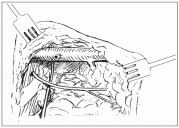Complications of Axillary Dissection
The axillary surgery causes the bulk of postoperative discomfort for breast cancer patients, and minor complications are frequent. Seromas are frequently seen, especially if the drain is removed early. These can be managed by aspiration in the outpatient clinic. In the long term, numbness in the medial aspect of the arm is universal if the intercostobrachial nerve has been divided.
Lymphedema and recurrent cellulitis are the most feared and potentially disabling of the complications. The reported incidence of lymphedema varies from 7-60% according to the methods used to assess the arm and the interval between surgery and follow-up. Many recent studies have reported a 15-20% incidence after treatment with axillary dissection or axillary irradiation. The incidence is much higher if both surgery and radiation therapy are used.
The extent of axillary surgery and the use of axillary radiation therapy are the only factors that have been consistently associated with the formation of lymphedema. Older age, obesity and infection are other likely risk factors.
Lymphedema can appear years after the surgery. It is routine to advise patients to avoid arm swelling and infection by taking special care not to suffer cuts and scrapes on the operated side, to avoid injections, blood-pressure monitoring, and blood draws, to avoid constricting clothing and jewelry, etc.
Warmuth reported a survey of 330 patients who were disease-free 2-5 years after surgery for early-stage breast cancer. Thirty-five percent reported numbness, 30% reported pain, 15% reported arm swelling, and 8% reported limitation of arm movement. Most of the symptoms were mild and did not interfere significantly with daily activity.
 Fig. 7.11. Axillary dissection in progress. The anterior tributary of the axillary vein has been divided, the intercostobrachial nerve has been preserved and the long thoracic nerve identified.
Fig. 7.11. Axillary dissection in progress. The anterior tributary of the axillary vein has been divided, the intercostobrachial nerve has been preserved and the long thoracic nerve identified.
Fig. 7.2. The skin and subcutaneous tissue is incised down to the vicinity of the mass.
Fig. 7.3. The mass is grasped with a clamp and excised using sharp dissection.
Fig. 7.4. The wound is closed with a subcuticular suture and steri-strips. The cavity is not closed.
Fig. 7.5. Skin flaps are marked to include the biopsy site. Enough skin is removed to result in a flat scar.
Fig. 7.6. Skin flaps are developed with upward traction on the skin, and countertraction on the breast. The breast is removed with its fascial envelope.
Fig. 7.7. The breast is removed along with the pectoralis fascia in a superomedial to inferolateral direction.
Fig. 7.8. The wound is closed over a suction drain (illustration shows a second drain in the axilla) using a subcuticular suture and steri-strips.
Fig. 7.9. Schematic diagram showing the incision for an axillary dissection and the extent to which flaps are elevated.
Fig. 7.10. Incision of the clavipectoral fascia along the lateral edge of the pectoralis minor and below the axillary vein. The position of the vein is outlined.
Fig. 7.11. Axillary dissection in progress. The anterior tributary of the axillary vein has been divided, the intercostobrachial nerve has been preserved and the long thoracic nerve identified.
Fig. 7.12. Advanced stage of axillary dissection. The thoracodorsal nerve has been preserved, and the tissue between the long thoracic and thoracodorsal nerves has been removed.
References
- Veronesi U, Saccozzi R, Del Vecchio M et al. Comparing radical mastectomy with quadrantectomy, axillary dissection, and radiation therapy in patients with small cancers of the breast. N Engl J Med 1981; 305:6-11.
This is the landmark report of the first randomized prospective trial of breast-conservation therapy. - Fisher B, Bauer M, Margolese R et al. Five-year results of a randomized clinical trial comparing total mastectomy and segmental mastectomy with or without radiation in the treatment of breast cancer. N Engl J Med 1985; 312:665-73.
This is the first report of the major North American trial of breast-conservation therapy from the NSABP. - Borgen PI, Heerdt AS, Moore MP et al. Breast conservation therapy for invasive carcinoma of the breast. Current Problems in Surgery 1995; 33:189-256.
This is a review of all aspects of breast-conservation therapy. - Fisher B, Costantino J, Redmond C et al. Lumpectomy compared with lumpectomy and radiation therapy for the treatment of intraductal breast cancer. N Engl J Med 1993: 1581-6.
This is the major trial of conservative therapy for DCIS - Adair F, Berg J, Joubert L et al. Long-term follow-up of breast cancer: the 30-year report. Cancer 1974; 33:1145-50.
This is an older report from the days before adjuvant therapy that demonstrates the effectiveness of surgery in node-positive disease. - Fisher B, Redmond C, Fisher E et al. Ten year result of a randomized clinical trial comparing radical mastectomy and total mastectomy with of without irradiation. N Engl J Med 1985; 312:674-81.
This is a very influential trial that showed that less-extensive surgery had similar results to radical mastectomy. - Warmuth MA, Bowen G, Prosnitz LR et al. Complications of axillary lymph node dissection for carcinoma of the breast: a report based on a patient survey. Cancer 1998; 83:1362-8.
This report gives a good idea of the range of complications after axillary dissection.
Patrick I. Borgen and Bruce Mann
Breast conservation therapy for invasive carcinoma of the breast. Current Problems in Surgery 1995; 33:189-256.